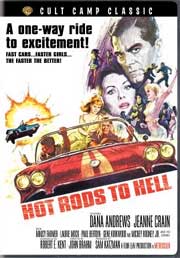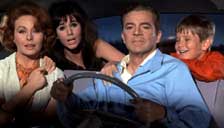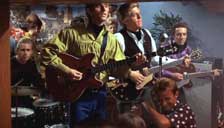 HOT
RODS TO HELL (1967)
HOT
RODS TO HELL (1967)Director: John Brahm
Warner Home Video
 HOT
RODS TO HELL (1967)
HOT
RODS TO HELL (1967)Once an overplayed
staple of several Ted Turner-owned TV stations, the cinematic epic that is HOT
RODS TO HELL has remained dormant for years now, and has never been given a
home video release. Now, Warner Home Video, in a continuing campaign to exploit
their vast film library, has liberated this 1967 MGM theatrical release to DVD,
aptly relegating it to the “Cult Camp Classics” series, available
to purchase separately or in a recommended“Terrorized Travelers”
box set with ZERO HOUR! and SKYJACKED.
After a late-night automobile accident leaves him with a bad back, family man Tom Phillips (Dana Andrews) decides to purchase and operate a hotel out in the California desert. This means relocating his family unit consisting of wife Peg (Jean Crain), teenage daughter Tina (Laurie Mock) and young son Jamie (Jeffrey Byron, aka Tim Stafford). During their desert highway travels, they find themselves under constant road rage abuse by a trio of teens – Duke (Paul Bertoya), Ernie (Gene Kirkwood) and peroxide blonde Gloria (Mimsy Farmer) – riding in a red Vette convertible. At times they enlist their hoodlum friends in their assorted jalopies to get in on the fun. The family just can’t seem to escape these clowns; lustful Duke approaches lone Tina at a picnic camp and when they finally make it to the hotel, they discover that its late-night lounge is their antagonists' hang-out of choice.
 HOT
RODS TO HELL contains all the right and wrong ingredients to hold its own as
a really bad movie, but the hodgepodge that unfolds is undeniably enjoyable,
making this an exemplary piece of drive-in trash, even though it looked very
antiquated by 1967 standards. Led by 1940s Hollywood stars Andrews and Crain,
the Phillips family belongs to the previous decade. Andrews plays it so square
and straight, that he's actually fun to watch, and even when he gets mad, he’s
able to keep his cool ala Ward Cleaver (if you think this was the worst thing
the actor was ever in, check out THE FROZEN DEAD which will hopefully get a
Warner DVD release as well). In the meantime, the redheaded Crain as the strong,
confident mom has to hold her own, often driving the car for her “sick”
husband and slapping her slightly rebellious daughter around and uttering such
banal dialogue as “there is no woman alive who doesn’t want a man.”
HOT
RODS TO HELL contains all the right and wrong ingredients to hold its own as
a really bad movie, but the hodgepodge that unfolds is undeniably enjoyable,
making this an exemplary piece of drive-in trash, even though it looked very
antiquated by 1967 standards. Led by 1940s Hollywood stars Andrews and Crain,
the Phillips family belongs to the previous decade. Andrews plays it so square
and straight, that he's actually fun to watch, and even when he gets mad, he’s
able to keep his cool ala Ward Cleaver (if you think this was the worst thing
the actor was ever in, check out THE FROZEN DEAD which will hopefully get a
Warner DVD release as well). In the meantime, the redheaded Crain as the strong,
confident mom has to hold her own, often driving the car for her “sick”
husband and slapping her slightly rebellious daughter around and uttering such
banal dialogue as “there is no woman alive who doesn’t want a man.”
If you look at other films of this sort (THE BORN LOSERS for example) from this period, you’ll realize how the heroes and villains of this piece are such throwbacks, and it doesn't help that they're subjected to bad rear projection effects during most of their driving scenes. As the primary annoying hot rodders, Paul Bertoya and Gene Kirkwood are too clean cut and well dressed, but they make it up by allowing their characters to be totally hateful. Mimsy Farmer is ultra cute and sexy as the bad girl, and it’s easy to see why she would become a Euro cult star in Italy by the early 1970s. It’s too bad that none of her other very similar drive-in films of this period (RIOT ON SUNSET STRIP, DEVIL’S ANGELS and THE WILD RACERS, all owned by MGM) are not yet out on DVD. Most of Fred Karger’s soundtrack is made up of continuous upbeat brassy kitsch music combined with melodramatic soapy harmonies for the more “serious” moments, but Mickey Rooney Jr. and his Combo get do perform a number of forgettable rockin’ tunes at the hotel’s lounge. Farmer, Kirkwood and Laurie Mock (a cute Marlo Thomas look-alike who delightfully overacts here) were all in the much more hip RIOT ON SUNSET STRIP, made not to long after HOT RODS by the same legendary producer, Sam Katzman. TV character actor George Ives is good as the slick-haired sleazy hotel owner, and the late Liz Renay (DESPERATE LIVING) has an unbilled bit as a barfly.
 Making
its home video debut on DVD, Warner grants us another beautiful transfer. The
film has been presented letterboxed at 1.78:1 with anamorphic enhancement. Some
sources say HOT RODS was filmed for television but considered too sensational
for that format, so it was then screened in theaters. Even if this is true,
it’s safe to say that it was shot for a widescreen intention, as the framing
looks correct and consistent without. The bright 1960s Metrocolor really stands
out, and the elements are in terrific shape with a few dashes of grain here
and there. The English language mono track is sufficient, and there are optional
English and French subtitles. By the way, this is the longer 100-minute cut
of the film, as MGM's original theatrical release ran a much more modest 92
minutes. The only extra is a rather battered full screen theatrical trailer.
(George
R. Reis)
Making
its home video debut on DVD, Warner grants us another beautiful transfer. The
film has been presented letterboxed at 1.78:1 with anamorphic enhancement. Some
sources say HOT RODS was filmed for television but considered too sensational
for that format, so it was then screened in theaters. Even if this is true,
it’s safe to say that it was shot for a widescreen intention, as the framing
looks correct and consistent without. The bright 1960s Metrocolor really stands
out, and the elements are in terrific shape with a few dashes of grain here
and there. The English language mono track is sufficient, and there are optional
English and French subtitles. By the way, this is the longer 100-minute cut
of the film, as MGM's original theatrical release ran a much more modest 92
minutes. The only extra is a rather battered full screen theatrical trailer.
(George
R. Reis)